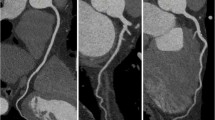Abstract
The term “chest pain with normal coronary arteries” encompasses a large number of different cardiac pathophysiological abnormalities, including impairment of coronary flow reserve, endothelial dysfunction, and early atherosclerosis that, in most cases, cannot be readily differentiated one from the other.
To study early coronary atherosclerosis, physicians must look beyond contrast filled arteries (so called lumenology). Angiograms cannot evaluate the vessel wall, plaque distribution and composition or other morphology. Plaques are often angiographically not visible due to their small size and compensatory enlargement (outward remodeling) of the coronary arteries. As a result, the search for an underlying atherosclerotic process remains ongoing. Available clinical studies showed that many patients with chest pain and normal angiography have early atherosclerosis as documented by intravascular ultrasound imaging, reduced coronary flow reserve and coronary endothelial dysfunction. Additional studies showed that patients presenting with normal coronary angiography have recurrent coronary events at long-term follow up.
Research to determine if improved diagnosis and treatment of quantitatively low degrees of atherosclerosis lead to improved outcomes of patients with normal angiography should be undertaken.
Zusammenfassung
Der Begriff „Brustschmerz mit normalem Koronarogramm“ umfasst eine große Zahl von verschiedenen kardialen pathophysiologischen Anomalien, z. B. eine Einschränkung der koronaren Flussreserve, eine endotheliale Dysfunktion und frühe Zeichen der Atherosklerose, die in vielen Fällen nicht voneinander differenziert werden können. Um die frühen Zeichen der koronaren Arteriosklerose zu erkennen, müssen weitergehende Untersuchungen zur reinen Kontrastangiographie (Konturmethode) durchgeführt werden. Die Angiographie kann die Gefäßwand, die Plaqueverteilung und die Plaquekomposition nicht darstellen. Plaques sind häufig angiographisch nicht sichtbar, weil sie umschrieben, klein und durch kompensatorische Gefäßerweiterungen (auswärts Remodeling) verdeckt werden. Deshalb muss die Suche nach einer möglicherweise vorhandenen arteriosklerotischen Erkrankung ausgedehnt werden. Verfügbare klinische Studien zeigen, dass viele Patienten mit Brustschmerz und normalen Koronararterien frühe Zeichen der Arteriosklerose aufweisen, die mittels intravaskulärem Ultraschall auch an einer reduzierten koronaren Flussreserve und einer gestörten Endothelfunktion erkannt werden können. Studien zeigen, dass bei Patienten mit normalem Koronarogramm wiederholte Koronarereignisse im Langzeitverlauf auftreten können. Studien müssen durchgeführt werden, um zu zeigen, ob Patienten mit einem Frühstadium der Arteriosklerose einen günstigen Verlauf zeigen, wenn frühzeitig die Diagnose gestellt und eine entsprechende Behandlung eingeleitet wird.
Similar content being viewed by others
Author information
Authors and Affiliations
Corresponding author
Rights and permissions
About this article
Cite this article
Bugiardini, R. Normal Coronary Arteries: Clinical Implications and Further Classification. Herz 30, 3–7 (2005). https://doi.org/10.1007/s00059-005-2659-8
Issue Date:
DOI: https://doi.org/10.1007/s00059-005-2659-8
Key Words:
- Normal coronary angiogram
- Syndrome X
- Endothelium dysfunction
- Coronary flow reserve
- Coronary atherosclerosis
- Endothelial dysfunction
- Microvascular function




